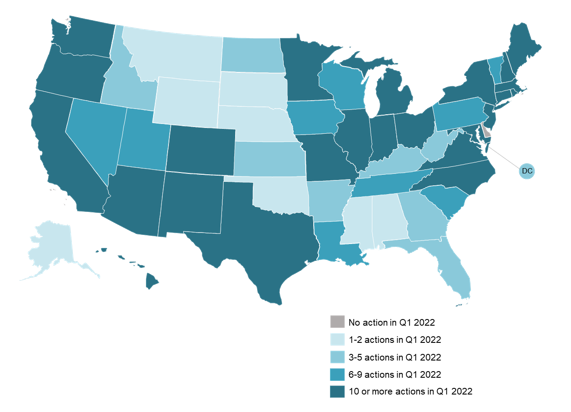The 50 States of Grid Modernization Q1 2022: States Focus on Promoting Grid Resiliency During Q1 2022
Raleigh, NC – (April 28, 2022) The N.C. Clean Energy Technology Center (NCCETC) released its Q1 2022 edition of The 50 States of Grid Modernization. The quarterly series provides insights on state regulatory and legislative discussions and actions on grid modernization, utility business model and rate reforms, energy storage, microgrids, and demand response.
The report finds that 49 states, as well as the District of Columbia, took actions related to grid modernization during Q1 2022 (see figure below), with the greatest number of actions relating to energy storage deployment (80), utility business model reforms (51), smart grid deployment (43), advanced metering infrastructure deployment (35), time-varying rates (30), and data access policies (28).
A total of 578 grid modernization actions were taken during Q1 2022. New York, Massachusetts, California, Illinois, Minnesota, Michigan, and Hawaii took the greatest number of actions during the quarter, followed by Washington, Connecticut, and Missouri.
Q1 2022 Legislative and Regulatory Action on Grid Modernization

The report discusses three trends in grid modernization actions taken in Q1 2022: (1) states examining decommissioning and recycling of energy storage systems; (2) utilities pursuing resiliency-as-a-service programs; and (3) state legislators exploring financing and incentives for resiliency improvements.
“Electric grid resiliency continues to be a concern to lawmakers, regulators, and utilities. Many states throughout the U.S. are taking grid resiliency-related planning actions or studying benefits of microgrids and energy storage within the context of resiliency,” said Vincent Potter, Policy Analyst at the NCCETC, “State regulators and lawmakers are seeking ways to maintain operations during weather events like hurricanes and ice storms and to minimize outage durations. Resilience studies and plans can also help regulators plan for current and future distributed energy generation resources on the electric grid, which, when combined with energy storage and microgrids, can be a potent resource to improve resiliency.”
The report notes the top five policy developments of Q1 2022 were:
- Virginia regulators approving Dominion Energy’s grid transformation plan;
- The New Mexico Energy Minerals, and Natural Resources Department releasing its grid modernization roadmap;
- The Hawaii Public Utilities Commission approving a bring your own device tariff framework;
- Maine and New Hampshire regulators addressing statewide energy data platforms; and
- New Jersey regulators approving Jersey Central Power & Light’s AMI deployment.
“Utilities in several states have proposed resiliency-as-a-service pilot programs involving deployment of utility-owned energy storage assets to customer locations to provide backup power in emergency situations,” said David Sarkisian, Senior Policy Project Manager at NCCETC. “A program of this type has already been approved in Wisconsin, and similar programs have been proposed in Colorado, California, Michigan, and Georgia as well.”
View the 50 States of Grid Modernization Q1 2022 Quarterly Report Executive Summary
View and Purchase the 50 States of Grid Modernization 2022 Q1 Update FULL Report
View other 50 States Reports – Solar, Grid Modernization and Electric Vehicles
ABOUT THE N.C. CLEAN ENERGY TECHNOLOGY CENTER
The N.C. Clean Energy Technology Center, as part of the College of Engineering at North Carolina State University, advances a sustainable energy economy by educating, demonstrating and providing support for clean energy technologies, practices and policies. It serves as a resource for innovative, sustainable energy technologies through technology demonstration, technical assistance, outreach and training. For more information about the Center, visit: http://www.nccleantech.